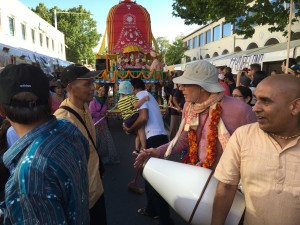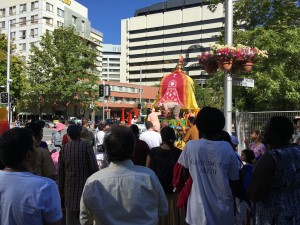By Bhagavan Das
Photos by Madhumati Radhika.
Considering the major part of the list of things to bring – mat, repellent, water bottle, flashlight – it may seem like a holiday camp like any other. However, it does not take too long until the recommended items reveal that it is a different kind of camp. The list shows: tilaka, japa-mala, devotional clothes. After all, as one can read in the promotional poster, it is “more than an retreat”. Indeed: it not a simple retreat, but a spiritual retreat, and unique to young vaishnavas.
It was in Nova Gokula, Pindamonhangaba, Brazil, that was held the second edition of Radha Krishna Camp (RKC). Surpassing the first edition of the event, the 2016 RKC, which took place from the 5th to the 12th of January, was attended by over 40 devotees, between 12 and 16 years of age, who went to an intensive retreat, where they could make new friends, have fun and experience an ideal spiritual life.

The beautiful landscape of Nova Gokula
Coinciding with the summer holidays in Brazil, RKC met the needs of the new generation of vaishnavas of engaging their free time in a healthy way, while they don’t have any school obligations.
Among children of Krishna devotees and children of supporters, the young devotees arrived “shy, quiet and resistant to change”, says Subhadra, one of the camp organizers. That already began to change on the first day, however, when, after the reception and presentation of the group leaders and of the general program, there were some games for interaction. “They know each other and develop friendship and complicity as the activities happen”, explains Subhadra.

“They know each other and develop friendship and complicity as the activities happen”
And there was no lack of activities at all. The teens and tweens, in addition to the temple routine, waking up before sunrise, also had a full day, every day, of activities planned to take place within Nova Gokula community and visitations outside the farm as well. “We avoided leisure time as much as possible. The program was developed to occupy them full time. Although it was exhausting sometimes, the intention was to avoid mishaps and unnecessary conflicts among participants”, explains Subhadra, which is an educational psychologist.
Among the activities carried out in the holy atmosphere of Nova Gokula, there was a lot of contact with nature: a visit to the stables, work in the garden and bathing in the river were some opportunities provided for participants for enjoying the simple life, away from the artificiality and pollution in urban environment. Vaikuntha Murti, Secretary for the Youth of ISKCON Brazil and Subhadra’s husband, says: “The visit to the goshala was surprising because many of them had little contact with nature, and although we had gone there just to observe, almost all of them asked to milk a cow and gave their best to achieve it, contrary to my expectations”.

Kids at the goshala
In the words of Purushatraya Swami, a Brazilian spiritual master, a visit to a farm where there is cow protection is an opportunity to “meditate with your eyes open”. There in Nova Gokula, the Deity of Krishna is known as Gokulananda, “the bliss of the house of the cows”. Certainly to see the cows of Krishna, milk them and then see the milk being taken away to make preparations for Krishna is a very special meditation with open eyes.
And that is the central point of all activities in RKC, of course. It is not just for a relaxing contact with nature, but for remembering Krishna in every act. Parama Karuna, one of the group leaders of the camp and he himself a son of devotees, says: “This project serves to educate and teach Krishna consciousness in a practical way. And this is very important, obviously”.
Well, if the goal is to have a day of cowherd boy, of a friend of Krishna, with river, milking and planting, let’s also add games and sports, because we know very well from the scriptures that the friends of Krishna used to have a lot of fun. These activities were due to Arjuna Sundara, expert at rappelling and kayaking, among other radical activities! Hiking, zip lines, volleyball and soccer made the joy of all.

Annapurna excited about the zip line
Now, if you think the “good youngsters” of RKC got excited only about running, diving and kicking a ball, you are sorely mistaken. Their interest for the pure wisdom of Krishna consciousness proved to be a great lust. “They undoubtedly showed how much they were eager to know more about the vaishnava philosophy and culture”, recalls Subhadra. “And they realized that there is a lot to be discovered and learned”.
The direct study of Krishna consciousness philosophy was facilitated by none other than Chandramukha Swami, a sannyasi of undeniably youthful spirit. The Bhagavad-gita and the chanting of the holy names were the main topics of study. “Maharaja Chandramukha loved the proposal of the RKC”, tells us Vaikuntha Murti. “He was delighted by the clever questions during his classes”.

Chandramukha Swami
Another delight to everybody was the art that permeated the days of the retreat. Drama and music, two arts well explored among followers of Sri Chaitanya since the beginning of gaudiya vaishnavism, were present there. “The spiritual interest had a better answer through music and drama, since theory for those who have so much energy is not very simple to be presented”, admits Katyayani, a group leaders, mentioning the peculiar nature of teenagers.
The dynamics of dramatic games, led by Murari Dasa, who has a degree in Drama, introduced the participants to professional concepts of staging, like recognition of space and movement, scenic body, voice, direction, speed etc. Murari tells us that he allowed everything to flow more freely, taking advantage of what they’ve brought from their cultural background and creativity. At the end, they analyzed the scenes together, discussing whether they could be improved in something, if they had a beginning and an end, and how they could give a more devotional flavor to it. Along this development of techniques, the workshops were designed to integrate well the participants – a goal which was certainly achieved.

Murari with the drama group
The musical height was the rehearsal with Chandramukha Swami, who has to his credit countless CDs recorded – there are so many that if you ask him the exact number, he will say that he does not know. After the private rehearsal, a presentation was made to the residents of Nova Gokula, with Chandramukha and his band accompanied by the choir of participants of the youth camp.
With so much motivation for the arts, Subhadra tells us that a bard was revealed from among the campers. “One of the participants demonstrated ability to produce songs, and as soon as the opportunity arose, he went on to sing about funny things that happened during the retreat, along with others. It was striking and very fun”.
If everything had come down to Nova Gokula, that would have not been a small event, but the spirit that Prabhupada instilled in us is of expanding, isn’t it? Time to hit the road, then. Three very nice activities beyond the gates of Krishna’s cows were waiting for the devotees.
In Taubaté, just one hour from Pindamonhangaba, they had the opportunity to visit the fire department of the city, where they learned more about this important profession in which men and women often risk their own life to save the lives of others. They learned, with the gentle presentation of two sergeants, basic guidelines for the prevention of fires and other accidents.

At the fire station
During the visit to the Cathedral of Saint Theresa, they were received by deacon Marcelo, who, with particular attention, share with them many details and curiosities of the cathedral and particularities of Catholicism, the biggest religion in Brazil. Then they had a meeting with Catholic youth, in an inter-religious interaction that provided to our young devotees the opportunity to know how the Catholic youth experiences their religion and vice versa. There was an exchange of questions about each other’s’ religion and, at the end, each group made an artistic performance. “It was a very rich and fruitful meeting”, recalls Vaikuntha.

Visit to the Cathedral of Saint Theresa
A third activity outside Nova Gokula was the visit to the central office of BBT, the official publisher of Srila Prabhupada’s books, sometimes referred to as “Prabhupada’s heart”. There, they had the opportunity to know the stages of production and distribution of a book, the physical facilities of the building and the importance of Srila Prabhupada’s books for preservation and propagation of Krishna’s teachings.

In the storage of BBT Brazil
On the last day, there was a retrospective of all the eight days of retreat, moments of reflection and a secret santa to definitively tie the bonds of friendship. “It was very cool… I am very sad that I have to come back home”, said Nina, 14. For Pedro, also 14, RKC was special because he could make new friends and develop his spirituality, “and there were also many interesting activities, such as games and sports”. Annapurna, also 14 years old, begins by highlighting the programs with Chandramukha Swami and the making of new friends, but soon she prefers not to highlight anything: “Everything was very special”.
It was not only the cowherd boys and young milkmaids who have learned and had good moments – the “big guys” behind the event too. Katyayani, one of the three group leaders in charge of the girls, says that by seeing the dedication of Subhadra, she came to admire even more her devoted colleague and feels realized for have being giving her company to all the children of devotees in a simple and spontaneous way, so that they may understand that the association of devotees is something light and natural. Vaikuntha Murti says that to be with the new generation renews his enthusiasm. “I’m dealing with the future of ISKCON, and it is very gratifying to know that our institution will have a bright future because we are investing in our young people”.

Friends
Murari summarizes RKC: “In my modest view, the basis of Bhagavad-gita is friendship and service. It is beautiful to see in RKC teenagers engaged in Krishna consciousness in this way. Each one of them came with their own style, with their particular tastes, but interacted with each other respecting and being respected with love and trust”.
Finally, Subhadra says: “I have a feeling of ‘mission accomplished’. Although our time with them is very short, I feel that they will take to their homes and their lives a little bit of what they lived with us. And it will make a difference”.
If it was “very short”, it is comforting to know that the “little bit” that they carry with them includes the desire to return. Tavares, 15, says: “A week of sheer devotion to Krishna, beautiful friendships, activities very well prepared – for sure I will come back”.

The whole “gang”, in front of the murti of Srila Prabhupada
There will be the third edition of RKC? Oh, yeah! The next editions are already being planned. Although they don’t have details yet, Subhadra and Vaikuntha already tell us they want to do something even bigger and also reach other age groups. They think it may be difficult to do it and they don’t know exactly where to begin from, but with the blessings of these dozens of special souls who return to their homes fully satisfied with them, would anyone doubt that they can do it?
* * *
Bhagavan Dasa is chief-editor of BBT Brazil and Back to Godhead Brazil. He has a degree in English language and literature, and has been working with translation and editing since 2005. Bhagavan Dasa is authour of three books, including a poetic version of the Bhagavad-gita. He is a initiated disciple of Dhanvantari Swami and lives in Juiz de Fora – MG, with his wife and their son, Hari (2).









 By Gour Govinda Swami
By Gour Govinda Swami















